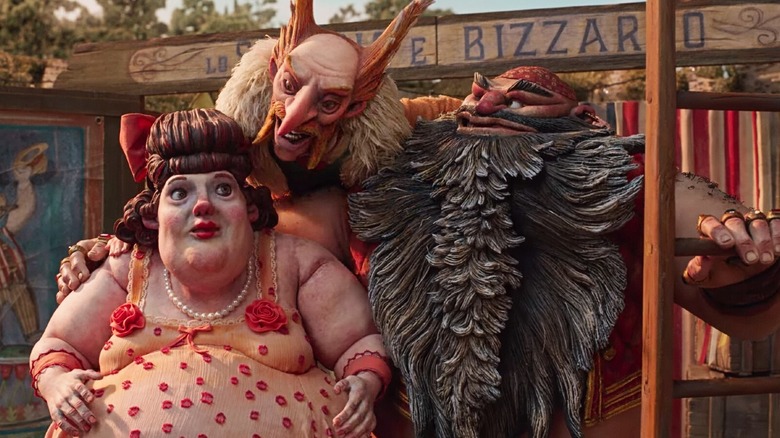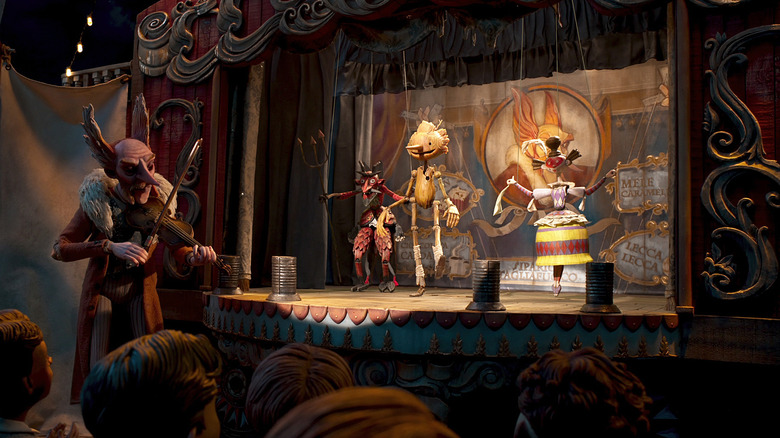Guillermo Del Toro Replaced Pinocchio's 'Crap' Original Villain, But He's Still In The Movie
Guillermo del Toro has a lot of unmade projects — like, a lot — but his list finally got a bit smaller, because the Oscar-winner finally got to make the stop-motion "Pinocchio" he dreamed about for over a decade. Not only that, but it is one of the best movies of the year, a beautiful story of imperfect fathers and imperfect sons, with another winning score from Alexandre Desplat, and a true marvel of animation.
We've already got three "Pinocchio" movies in 2022, including two animated takes on Carlo Collodi's classic children's book "The Adventures of Pinocchio." Still, del Toro's is the only one taking place in 1930s fascist Italy, and the only one to be made in the classic technique of stop-motion. Both of these are essential to what makes this film so special and unique. The stop-motion gives "Pinocchio" a unique look that marries del Toro's passion for animation with his experience working in live-action. With cinematography that makes the sets come alive, grand sets, and animation that includes unnecessary movements to make the characters feel like real people, there's no movie that looks like this.
Then there's the historical setting is not just window dressing, it is an essential part of the plot and is vital to the film's themes of disobedience and staying true to yourself. Likewise, the script does several big changes to the source material that make this version feel fresh, like swapping Pleasure Island for a military youth camp, and also changing the main villain of the film.
Goodbye, Mangiafuoco
In the original novel, the main villain is a guy named Mangiafuoco, a theater director and puppet master who once threatens to burn Pinocchio for ruining his show. Mangiafuoco was renamed Stromboli in the classic Disney film and is a showman who earns money by putting Pinocchio on stage.
For his stop-motion debut, del Toro had originally cast Ron Perlman to voice the character of Mangiafuoco, and the sculptors built an intricate puppet of the character with a huge beard. Only, if you've seen the film, you might notice that there is no one named Mangiafuoco. That's because del Toro changed his mind halfway through production. In a behind-the-scenes documentary about "Pinocchio" that just hit Netflix, del Toro talks about realizing that the villain was a cliché and he didn't like it.
According to first Assistant Director Jared Bumgarner, del Toro approached the team one day and said simply, "I think our main villain is crap, and I want to change it." Having already spent a long time building the Mangiafuoco puppet, they couldn't simply toss it into the garbage and start fresh, so instead, he became a background character working in the circus.
Ron Perlman was recast as the fascist villain, Podesta, and the main villain became an amalgamation of the Fox and the Cat from the original book, now named Count Volpe — voiced by Christoph Waltz. According to del Toro, Volpe is closer to the literal devil, a more over-the-top character than the Fox and the Cat, and he's right. He's the closest the film gets to the more fantastical and cartoonish tone of the book, a comically evil man.
Hand-carved cinema
The entire documentary is worth watching, as it gets deep into the arduous journey to get the film made, and the attention to detail given to every aspect of "Pinocchio."
It is also a great explanation of what makes stop-motion such a special art form. As director Mark Gustafson says in the documentary, "there's a sophistication of filmmaking when it's applied to stop motion which is inherently handcrafted."
Indeed, more than any other medium, in stop-motion, everything is built and everything is planned. There's little room for improvisation like in live-action, and unlike traditional animation, everything is hand-carved. The sets feel like real Italian locations, the lighting feels natural, and the characters are tactile. As co-production designer Curt Enderle says, "everything has to be built, you fully create a world."
"Pinocchio" is now streaming on Netflix.

